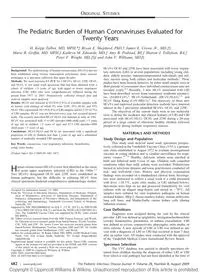
2009 The Pediatric Burden of Human Coronaviruses Evaluated for Twenty Years PDF
Preview 2009 The Pediatric Burden of Human Coronaviruses Evaluated for Twenty Years
ORIGINAL STUDIES The Pediatric Burden of Human Coronaviruses Evaluated for Twenty Years H. Keipp Talbot, MD, MPH,*‡ Bryan E. Shepherd, PhD,† James E. Crowe Jr., MD,‡� Marie R. Griffin, MD, MPH,§ Kathryn M. Edwards, MD,‡ Amy B. Podsiad, BS,‡ Sharon J. Tollefson, BA,‡ Peter F. Wright, MD,‡�§ and John V. Williams, MD‡� Background: The epidemiology of human coronaviruses (HCoVs) has not been established using reverse transcription polymerase chain reaction techniques in a specimen collection that spans decades. Methods: We used real-time RT-PCR for 3 HCoVs, HCoV 229E, OC43, and NL63, to test nasal wash specimens that had been obtained from a cohort of children �5 years of age with upper or lower respiratory infection (URI, LRI) who were comprehensively followed during the period from 1977 to 2001. Prospectively collected clinical data and archival samples were analyzed. Results: HCoV was detected in 92/1854 (5.0%) of available samples with no known viral etiology of which 9% were 229E, 59% OC43, and 33% NL63. This represented 10/119 (8.4%) of LRI samples and 82/1735 (4.7%) of URI samples. HCoV was not detected every year, but occurred episod- ically. The recently described HCoV-NL63 was detected as early as 1981. HCoV was associated with 11.4 LRI episodes/1000 child-years �5 years of age (all in children �2 years of age) and 67.3 URI episodes/1000 child-years �5 years of age. Conclusions: HCoV-NL63 and OC43 are associated with a significant proportion of LRI in children less than 2 years of age and a substantial number of medically attended URI episodes. Key Words: coronavirus, viral respiratory infections, bronchiolitis, croup, otitis media (Pediatr Infect Dis J 2009;28: 682–687) H uman coronaviruses (HCoVs) were first identified as the cause of acute upper respiratory infection (URI) in the 1960s.1,2 Two HCoVs designated OC43 and 229E were established as human pathogens, but the difficulty in culturing HCoV from clinical specimens hindered comprehensive epidemiologic studies. HCoVs OC43 and 229E have been associated with lower respira- tory infection (LRI) in several populations, including young chil- dren, elderly persons, immunocompromised individuals, and mil- itary recruits using both culture and molecular methods.3 These studies have been limited, however, by either small sample sizes or short periods of assessment since individual coronaviruses may not circulate yearly.4,5 Recently, 3 new HCoV associated with LRI have been described: severe acute respiratory syndrome coronavi- rus (SARS-CoV),6 HCoV-Netherlands (HCoV-NL63),7,8 and HCoV Hong Kong (CoV-HKU1).9 The discovery of these new HCoVs and improved molecular detection methods have renewed interest in the 2 previously identified HCoVs, OC43, and 229E. The objectives of the current study were to use molecular tools to define the incidence and clinical features of URI and LRI associated with HCoV-NL63, OC43, and 229E during a 20-year period in a large cohort of otherwise healthy children followed prospectively during multiple respiratory seasons. MATERIALS AND METHODS Study Design and Population This study used archival nasal wash specimens prospec- tively collected in the Vanderbilt Vaccine Clinic (VVC), a primary care clinic established in August 1972 to evaluate investigational vaccines in young children and to conduct surveillance for respi- ratory viruses.10–14 Healthy, full-term infants were enrolled at birth and followed until 5-year of age. Children with comorbid conditions other than mild asthma were excluded. Pediatricians trained in infectious diseases and nurse practitioners conducted all sick- and well-child visits. History and physical examination findings were recorded on a standardized clinical form. Investiga- tors were instructed to collect a nasal wash if a child presented with fever �38.3°C, acute otitis media, or LRI (defined below). Specimens were kept on ice and processed immediately for viral cultures with an aliquot snap-frozen and stored at �70°C. All samples were cultured for viral respiratory pathogens on human neonatal kidney, HEp-2, rhesus monkey kidney, human embryonic lung cell lines, and Madin-Darby canine kidney cells (during influenza season). Case Definitions Diagnoses were assigned during the visit by the clinical provider. LRI was defined as epiglottitis, laryngotracheobronchitis (croup), bronchiolitis, pneumonia, or asthma exacerbation. URI was defined as coryza, conjunctivitis, pharyngitis, otitis media, or otitis externa. A new episode of LRI or URI was defined as any visit with a diagnosis of LRI or URI that occurred at least 7 days after an earlier visit. All studies were conducted with the approval of the Vanderbilt Medical Center Institutional Review Board. Specimen Selection The VVC database was queried to identify specimens ob- tained from children meeting the diagnosis of either LRI or URI from which a viral pathogen had not been identified at the time of Accepted for publication January 19, 2009. From the *Division of Infectious Diseases, Department of Medicine, †Depart- ment of Biostatistics, ‡Division of Infectious Diseases, Department of Pediatrics, §Department of Preventive Medicine, and �Department of Mi- crobiology and Immunology, Vanderbilt University School of Medicine, Nashville, TN. Supported by NIH 5R03AI068069-02 (to H.K.T., J.V.W., B.E.S.), by NIH/NCRR (5 K12 RR017697-05) (to H.K.T.), and from the NIAID (1K23AI074863-01). Also, The Vanderbilt Vaccine Clinic was supported by GCRC center (award RR 00095). Dr. Talbot receives research funds from the NIH, Protein Sciences, and Wyeth, Dr. Edwards receives research grants from Sanofi Pasteur, Wyeth, Novartis, CSL, NIH, and CDC. Dr. James Crowe has received research grants from Sanofi Pasteur, MedImmune, VaxGen, Alnylam, NIH, and CDC. Dr. Griffin has research grants from MedImmune, CDC, and Merck. Address for correspondence: H. Keipp Talbot, MD, MPH, A2200 Medical Center North, 1161 21st Avenue South, Nashville, TN. E-mail:
